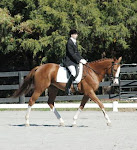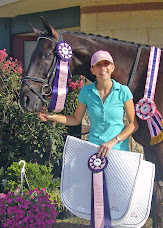The hotline is available at 866/634-0030, and is the result of a horse industry emergency roundtable meeting held Jan. 23, 2008. Attendees--including a number of breed, veterinarian, rescue, and animal control groups--engaged in a lively and in-depth discussion of the current hay and unwanted horse situation in Kentucky. Solutions, problems, and difficulties addressing the growing
concerns were discussed. The new hotline was one of the tools proposed in this
meeting. The assistance provided through the hotline will be supported by
donations to the Save Our Horses (SOHO) Fund. Donations can be made to SOHO
online or via mail to: Kentucky Horse Council, 4063 Iron Works Parkway,
Suite 2, Lexington, KY 40511.
Saturday, February 23, 2008
Horse Help Hotline Introduced by Kentucky Horse Council
Friday, February 22, 2008
Ask the Farrier - Shoes Needed on a Flat Footed Horse?
Elaine from Raleigh, NC asks this question: "I recently purchased a 4 year old Thoroughbred/Percheron cross gelding who passed his pre-purchase with no problems, however, the vet commented that he has flat feet and I should put shoes on him before I work him so that his soles don't get sore. He has been in light ring-work before I purchased him. I plan to train him for eventing, and we will jumping little stuff in a few months. Is there a certain type of shoe for flat footed horses? Should he have pads? Thanks."
Thanks for your question Elaine! Look for the answer from certified farrier Arvin Reynolds to be posted here Wednesday morning, Feb 27th. Congratulations on your new purchase!
Thursday, February 21, 2008
The Bran Mash Controversy - Helpful or Harmful?
 It's only in the mid-thirties here in Virginia today for a high - the air is cold and dry, the ground in covered in snow and tomorrow we're expecting another small snow storm. I'm thinking bran mash! and, I think, so are the horses in the barn after spending a boring day munching dry hay. But there are the Bran Mash Downers out there, and I thought it would be a good day to highlight some arguments from both sides (for fun, let's call them the Bran Booers and the Bran Brigade).
It's only in the mid-thirties here in Virginia today for a high - the air is cold and dry, the ground in covered in snow and tomorrow we're expecting another small snow storm. I'm thinking bran mash! and, I think, so are the horses in the barn after spending a boring day munching dry hay. But there are the Bran Mash Downers out there, and I thought it would be a good day to highlight some arguments from both sides (for fun, let's call them the Bran Booers and the Bran Brigade).
their diet in fodder such as hay or grass. The addition of bran whether wet or
dry is not likely to be a benefit."
Wednesday, February 20, 2008
Three Simple Winter Riding Tune-Ups
It's supposed to snow here in Virginia today - if it's snowing where you are, hopefully you're blessed with an indoor. If you are riding, no matter your discipline, here's three simple riding tune-up exercises to fight the trapped-in-the-indoor winter doldrums.
1) Calling the Footfalls: Can you accurately sound-off when your horses hooves hit the ground and push off again? It may sound nit-picky, but being able to time your aides requires being able to feel where the horse's body is and where it's going next. At the walk, try to call out "Now" or something similar when you feel the inside hind leg push off the ground. (If you don't have a mirror, you'll need a groundperson to verify). Connect the feeling in your seatbone to the moment when that hoof pushes off - now you know the perfect time to give the canter aid (for a walk to canter transition). The horse technically strikes off with the outside hind, but using the timing for the inside hind will give you just the right "time-delay" from your aide to the horse's reaction. Focusing on the inside hind will also help you "lift" the horse into the canter instead of pushing his haunches in by driving the outside hind.
2) Checking the Horse's Straightness: If you have a mirror, practice your transitions traveling toward the mirror, but on the inside track. You might be surprised how much your horse has been relying on the track instead of staying between your aides. If you have no mirrors but you have an indoor, pick a line from the ceiling (not on the track) - a sprinkler pipe, electrical housing, support beam - and ride under it, tilting your head as far back as you can, so you can't focus your eyes straight ahead. Concentrate on the line overhead and try to develop the feel of when your horse's body moves out out of alignment. When you can ride the line without drifiting, try simple transitions, also with your head back. Putting your head back will help develop feel in your seat and tends to make your seat deeper, too.
3) Checking the Rider's Straightness: The simplest way to check rider straightness is to ask an experienced groundperson or trainer to watch you ride in a straight line away and give an honest assessment. If you are on your own, however, you are not at a loss....try this: at the halt, lift both upper and low legs slightly away from the saddle so you are left balancing primarily on your seatsbones - ask the horse to walk on and note if you slip to one side of the saddle or the other. If you have to catch yourself with your right thigh right away, you are probably used to sitting too much to the left. Another easy correction is to make yourself ride without stirrups on a regular basis - even if you only practice turns at the walk, riding sans stirrups will encourage you to stay more centered.
Happy Winter Riding!
Tuesday, February 19, 2008
Feel Good of the Day - The Power of Ponies
Amid the happy crowd Saturday, Orion, 11, stood out. She was singing a show tuneHappy Riding Today!
and throwing her arms out as if to embrace the world as she rode Snapper, a
quarter horse. “She's loud, but she's happy loud,” said Dawn Smith, Orion's
grandmother. Orion's exuberant spirits are a dramatic turnaround from her
anger and sadness of three years ago, before she began attending riding program,
Smith said. A rough start in life, emotional difficulties and abuse had put
Orion on a disastrous path. Smith said the program “saved Orion's life. I
don't think I can express the depth of how I feel about this.”
Monday, February 18, 2008
Make the Most of Your Dressage Whip
 Here's a few tips on Using the Dressage Whip Effectively from the Good HorsePerson:
Here's a few tips on Using the Dressage Whip Effectively from the Good HorsePerson:
1) Grip - Find the grip that you like best - thick rubber has a lot of stick-tuiveness but it's heavy. Leather over fiberglass is lightweight but can be slippery. Rubber spiral can be a good intermediate choice for grip without bulk.
2) Topper - Do you like the gleam and solidity of a big metal topper, or does a light plastic little mushroom feel better? It's all about how comfortable it feels in your hand with the rein. A topper is absolutely necessary to carry a whip properly - without one, you have to grip the whip too hard to keep it from sliding through your hand and you will end up compromising the feel of that rein.
3) Length - Let's face it...a tiny person on a huge horse needs a bigger whip, it's all about proportion. The whip should point at a forty-five degree angle - the lash should point below the hip bone of the horse and just above the corner of a square saddle pad. Don't forget the relatively new length rule for dressage competition - you might have to swap your schooling whip for a shorter one at shows, or you might be able to trim off the lash to make it fit.
4) Flexibility - Find a whip that has the right "snap" for your horse - a really stiff whip won't give as big of a bite and is easier to control (probably better for sensitive horses). A whip with a lot of give will give bigger bites when you really flick it - probably best for Joe Slow or warmbloods with thicker hides or duller brains.
5) Weight - this aspect is last, because if the other four are suitable to you, weight will probably be also. But it's good to try lots of different whips - the material and shape of the handle and body affect how the whip balances in your hand. If you feel like you can hold it with little effort, it's probably a good choice.
Finally, if you feel like you have the perfect whip, but using it is still not coming naturally, check your hand position and "flicking style." If the whip is hitting too high or too low, your hand is probably improperly flexed at the wrist. Try letting your hand fall naturally from your wrist and resist the urge to twist it to move your horse's head position, instead, shorten the rein or move your arm slightly. As for flicking style - again, check the wrist flexion while flicking - just turn your outside knuckles out momentarily and then "close that little window" by snapping your wrist back into position with conviction. Concentrate on this action and let the result be that the whip hits the horse. Resist the urge to move your arm back or to open your arm/elbow away from the body. Soon you will be super subtle and the whip will be your extra appendage!
Photo courtesy of: http://www.horseshows.com.au/gregwatsoncanes.htm What fancy whip toppers they have!








